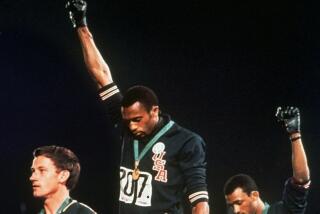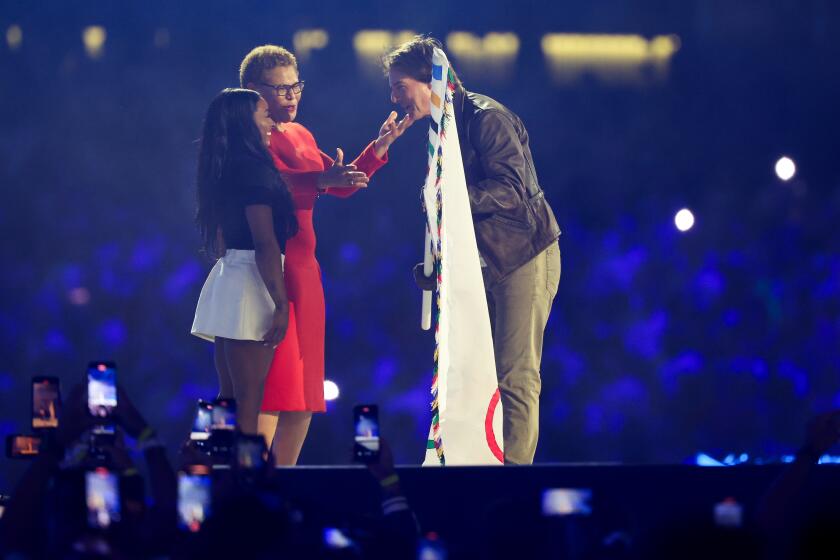Tribute to 9/11 Victims Disallowed
PARK CITY, Utah — The taping over of uniform logos has long been a painful ritual for Olympic athletes, individual expression and sponsorship having to give way to a mass umbrella of corporate commercialism.
New York City paramedic Michael Voudouris thought the International Olympic Committee might make an exception in his case.
He was wrong and doesn’t have nearly enough tape to cover his tracks.
Voudouris, 41, learned through back channels he will not be able to race in Wednesday’s men’s skeleton event at Utah Olympic Park with a sled he dedicated to lives lost in the terrorist attacks of Sept. 11.
Voudouris, who lives in New York but races for Greece under dual citizenship, is an emergency medical technician who raced to ground zero on Sept. 11 to help with the rescue effort. The soot and ash from the scene scratched his cornea and fouled his bronchial passages.
He ground his teeth so much in his sleep, a result of recurring nightmares, he said he fractured his molars and had to have a double root canal.
When Voudouris miraculously made the Greek Olympic team in skeleton by nabbing the final qualifying spot by one-hundredth of a second, he decided he was going to find a way to pay his respects.
So, on the bottom of his sled, he painted an abstract of the World Trade Center’s twin towers and etched other reminders.
“Greece lost 30 people,” Voudouris said, “I have the No. 30, and that’s not allowed on it. That’s a political statement. And I have my high school that lost 32 people. Firemen and parents of students.”
Voudouris used his sled in World Cup competition but cannot in Olympic competition under IOC Rule 61, which prevents the display of commercial logos or statements that can be seen as political.
Voudouris has almost no chance of winning a medal. This isn’t short-track speedskating, where a crash on the final turn can bump last place to gold.
Voudouris was ranked 41st on the World Cup circuit and finished 24th of 26 racers in Monday’s training run.
Yet he was hoping to bring something to these Games--his heartfelt feelings.
He said it was unlikely anyone would even see his artwork.
“It’s on the underside,” he said. “No one’s going to see it unless it flips over.”
Voudouris had guessed his sled would not be approved, so he quietly put out an inquiry and got the answer he expected.
“They’re doing the courtesy of telling me now so I have three days to decide what to do,” Voudouris said. “To either get disqualified, to remove the thing off my sled, which I don’t want to do. Or to find a new sled.”
He may end up with option No. 3. Voudouris has been offered a backup sled from American Trevor Christie, who did not qualify for the Olympics.
An international bobsled spokesman told Associated Press on Monday that the federation did not want to become any part of a controversy.
“The [International Bobsled Federation] says it is a problem, remove it,” Voudouris said of his sled. “They said the IOC came back to them and said it’s not allowed to have anything like that that might be considered remotely as a political statement.”
Voudouris still hasn’t decided what he’s going to do. Since home country flags are allowed to be displayed, he may stick 30 tiny Greek flags on the bottom to honor those who died on Sept. 11.
“I’m allowed the Greek flag,” he said. “They didn’t say how many.”
Voudouris is also torn.
“I don’t want to hurt the sport, because they’ve worked very hard to get here,” he said.
So what’s he going to do?’
“We’ll have to wait until Wednesday,” he said. “They might catch it and I might get disqualified, or they might say I have to remove that and I might have time to remove that. But I’ve got to do something.”
Voudouris began skeleton, a luge-like event in which racers go face-first down an ice track, only in 1996. This is the first time skeleton has been an Olympic event since the 1948 St. Moritz Games.
Voudouris, a former sports photographer, was introduced to the sport while on a photo shoot of former racer Julie Walker. She wouldn’t allow him to take pictures until he tried a run first.
One run was all it took for Voudouris to become hooked.
In the wake of Sept. 11, Voudouris says racing skeleton has been a welcome release. Many see the sport as dangerous and those who race as crazed adrenaline freaks. Voudouris says his mind starts to unwind on the six-hour drive from his home in New York to the training track in Lake Placid.
“I find it very relaxing, soothing,” he said of the sport. “This thing, you get up on top and the whole world shuts off, but then it opens up and you say, ‘Oh my God, I’m going to throw myself on this thing real fast and I’m going 75 mph.’
“There are times when it’s almost like you’ve stopped moving and everything else moves around you.
“It’s almost like virtual reality, until you get hit. And then it’s back to reality.”
More to Read
Go beyond the scoreboard
Get the latest on L.A.'s teams in the daily Sports Report newsletter.
You may occasionally receive promotional content from the Los Angeles Times.








